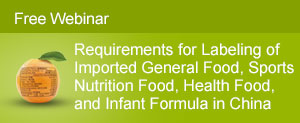The National Health and Family Planning Commission of the People’s Republic of China (NHFPC) have published hundreds of new food raw materials since 1988. CIRS’s food regulatory team has compiled the positive list of new food raw materials from 1988 to 2014 (please refer to the table at the end of this article which shows the positive list of new food material from 2013 to 2014). CIRS hopes to help you to know the industry dynamic clearly.
What is new food raw material?
New food materials refer to the following objects/materials that are not traditionally consumed in China:
1. Animal, plant and microorganisms;
2. Substances derived from animals, plants and microorganisms;
3. Food substances whose structure has changed;
4. Other newly developed food materials.
Why to apply for the permit of new food raw materials?
The administrative measures for safety review of new food materials have been issued by National Health and Family Planning Commission (NHFPC) on 31 May 2013. This regulation has come into force on 1 October 2013. Companies should apply to the certificate for their new food materials prior to making the materials available in the Chinese market.
How to apply?
Regulation on application approaches of new food material and regulation on safety assessment of new food materials have been issued by NHFPC on 15 October 2013 and came into force immediately. These provisions have specified the data requirements, application, safety assessment and On-site examination.
Data requirements
1. Component analysis report
2. Hygienic test report
3. Toxicity studies reports
4. Resistant microbe and toxin producing ability test report
5. Safety assessment report
The toxicity studies reports, the resistant microbe and toxin producing ability test report could be provided by oversea laboratories with OECD GLP qualification. Other studies should be conducted in China by test laboratories with CMAF qualification.
Toxicity studies for various product categories
In accordance with the Regulation on application approaches of new food material, the data requirements are different for various product categories of new food material application in China:
| Test items | Animal and plant sources | Microorganisms sources | |||||
| Is that traditionally consumed outside of China? | NO | Yes, only in few countries. | Yes, it has been widely consumed in other countries | NO | Yes, only in few countries. | Yes, it has been widely consumed in other countries | |
| 1 | Acute oral toxicity test | × | × | × | × | × | × |
| 2 | Three genetic toxicity tests | × | × | × | × | × | - |
| 3 | Two genetic toxicity tests | - | - | - | - | - | × |
| 4 | 90 days oral toxicity test | × | × | - | × | × | - |
| 5 | 28 days oral toxicity test | - | - | × | - | - | - |
| 6 | Teratogenicity test | × | × | - | × | - | - |
| 7 | Reproductive toxicity test | × | ×* | - | × | - | - |
| 8 | Chronic toxicity and carcinogenicity tests | × | - | - | - | - | - |
| 9 | Metabolic test | × | - | - | - | - | - |
Positive list of new food raw materials from 2013 to 2014
| S.N. | Chinese Name | Latin Name / English Name |
| 1 | 线叶金雀花 | Aspalathus Linearis (Brum. f.) R. Dahlgren |
| 2 | 塔格糖 | Tagatose |
| 3 | 奇亚籽 | Chia seed |
| 4 | 圆苞车前子壳 | Psyllium seed husk |
| 5 | 罗伊氏乳杆菌 | Lactobacillus reuteri |
| 6 | 蛹虫草 | Cordyceps militaris |
| 7 | 植物甾烷醇酯 | Plant stanol ester |
| 8 | 壳寡糖 | Chitosan Oligosaccharide |
| 9 | 水飞蓟籽油 | Silybum marianum Seed oil |
| 10 | 柳叶蜡梅 | Chmonathus salicifolius S.Y.H |
| 11 | 杜仲雄花 | Male flower of Eucommia ulmoides |
| 12 | 乳酸片球菌 | Pediococcus acidilactici |
| 13 | 戊糖片球菌 | Pediococcus pentosaceus |
| 14 | 显齿蛇葡萄叶 | Ampelopsis grossedentata |
| 15 | 磷虾油 | Euphausia superba Dana |
| 16 | 马克斯克鲁维酵母 | Kluyveromyces marxianus |
| 17 | 裸藻 | Euglena gracilis |
| 18 | 1,6-二磷酸果糖三钠盐 | D-Fructose 1, 6-diphosphate trisodium salt |
| 19 | 丹凤牡丹花 | Paeonia ostii T. Hong et J. X. Zhang |
| 20 | 狭基线纹香茶菜 | Isodon lophanthoides (Buchanan-Hamilton ex D.Don) H. Hara var. gerardianus (Bentham) H. Hara |
| 21 | 长柄扁桃油 | Amygdalus pedunculata Oil |
| 22 | 光皮梾木果油 | Swida wilsoniana Oil |
| 23 | 青钱柳叶 | Cyclocarya paliurus |
| 24 | 低聚甘露糖 | Mannan oligosaccharide(MOS) |
| 25 | 茶树花 | Tea blossom |
| 26 | 盐地碱蓬籽油 | Suaeda salsa seed Oil |
| 27 | 美藤果油 | Sacha Inchi Oil |
| 28 | 盐肤木果油 | Sumac Fruit Oil |
| 29 | 广东虫草子实体 | Cordyceps guangdongensis |
| 30 | 阿萨伊果 | Acai |
| 31 | 茶藨子叶状层菌发酵菌丝体 | Phylloporia ribis (Schumach: Fr.) Ryvarden |
From the positive list of new food raw materials from 1988 to 2014, we can know whether the raw material have been permitted yet. Furthermore, some new food raw materials are only permitted to use in certain foods. For example, the tagatose could be added into every food except infant food. Tea blossom would be used without limits of application scope and intake. D-Fructose 1, 6-diphosphate trisodium salt is merely allowed to be used in sports drink, but not for infant and pregnant women. Meanwhile, the acceptable daily intake is 300mg.
We would offer you consulting service for free before 1 September 2014, such as checking whether the raw material is a permitted new food raw material, the scope of application and so on.
If you would like to get the detailed positive list or other relevant information, pleases send us an email.
Contact Us
Ms. Cathy Yu, Senior Consultant, Food Safety Regulation, CIRS China
11F Dongguan Building, 288 Qiuyi Road, Binjiang District, Hangzhou, China, 310020
Tel : +86 571 8720 6564 | Fax : +86 571 8720 6533
Email: cathy.yu@cirs-group.com






